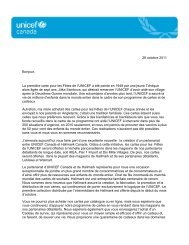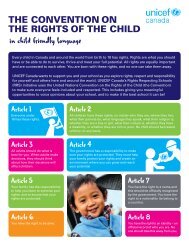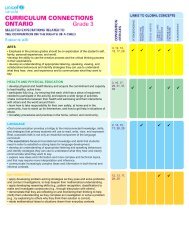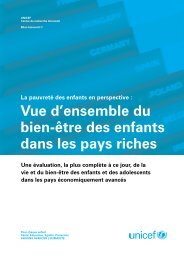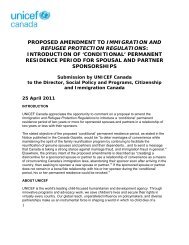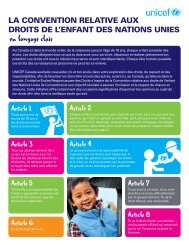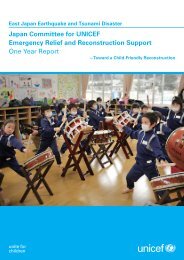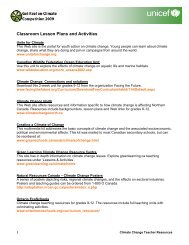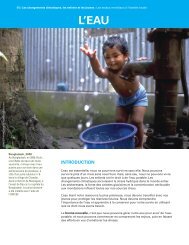Energy - UNICEF Canada
Energy - UNICEF Canada
Energy - UNICEF Canada
You also want an ePaper? Increase the reach of your titles
YUMPU automatically turns print PDFs into web optimized ePapers that Google loves.
Climate Change, Children and Youth: Local Connections to Global Issues | 81<br />
ENERGY<br />
© <strong>UNICEF</strong>/NYHQ2008-1133/Christine Nesbitt<br />
INTRODUCTION<br />
<strong>Energy</strong> is vital to sustain our lives. We use energy in every aspect of our lives;<br />
growing, transporting food and cooking it, heating or cooling our homes, for<br />
light, in manufacturing and for powering our cars.<br />
Cape Verde, 2008<br />
Wind turbines generate<br />
electricity in the mountains<br />
of Praia, the capital of<br />
Santiago Island.<br />
Currently most of the world’s energy is from fossil fuels: coal, gas and oil.<br />
Burning of fossil fuels not only creates carbon dioxide, but affects our air quality<br />
and exacerbates climate change.<br />
This effect particularly impacts children, and those most vulnerable are in<br />
developing countries. Youth in <strong>Canada</strong> are also affected; issues of asthma and<br />
breathing disorders are on the rise and quality of life is compromised.<br />
Children have the right to clean air, and the good news is we can use<br />
renewable energy sources to help reduce our dependence on fossil fuels. We can<br />
start by understanding the issues and then doing our part to make a difference.
82 | Climate Change, Children and Youth: Local Connections to Global Issues<br />
ACTIVITIES<br />
The curricula links below are addressed in this theme. For an extensive list of relevant provincial<br />
expectations/outcomes, refer to Appendices A and B: Curriculum Links on pages 91 and 95, and Appendix<br />
I for links in Alberta, Saskatchewan, Manitoba and Quebec. .<br />
Province Course Expectation/Learning Outcome<br />
Ontario SVN3M F1. assess the impact on society and the<br />
Environmental Science,<br />
environment of the use of various renewable<br />
Grade 11, University/College and non-renewable energy sources, and<br />
Preparation<br />
propose a plan to reduce energy consumption;<br />
Conservation of <strong>Energy</strong><br />
F3. demonstrate an understanding of energy<br />
production, consumption, and conservation<br />
with respect to a variety of renewable and<br />
non-renewable sources.<br />
Ontario SNC1P Science 9 Applied E1. assess the major social, economic, and<br />
environmental costs and benefits of using<br />
Physics<br />
electrical energy, distinguishing between<br />
renewable and non-renewable sources and<br />
propose a plan of action to reduce energy costs.<br />
British Columbia Science 9 Relate electrical energy to power consumption.<br />
Physical Science:<br />
Characteristics of Electricity<br />
British Columbia Sustainable Resources 11 Describe the processes associated with the<br />
generation and use of energy resources.<br />
Setting the Stage<br />
Objective: Students discuss viable renewable energy sources.<br />
Time: 15 minutes<br />
Materials<br />
• Renewable <strong>Energy</strong> Cards (optional)<br />
• Renewable <strong>Energy</strong> Defined answer key<br />
• Appendix G: Reflect and Act (page 105)<br />
ACTIVITY<br />
1. Distribute Appendix G: Reflect and Act (page 105) to each student and ask them to journal lessons<br />
learned during discussion and activities around the theme.<br />
2. Arrange the class into six groups. Give each group a set of the Renewable <strong>Energy</strong> Cards. If the<br />
students have basic knowledge of the different renewable energy sources, play this game without the<br />
cards, or list of the answers.
Climate Change, Children and Youth: Local Connections to Global Issues | 83<br />
3. Read to the class the first definition (only) from the<br />
Renewable <strong>Energy</strong> Defined answer key. Each group is to<br />
decide what renewable energy source matches the<br />
definition, and choose a renewable energy card from their<br />
deck. Once that card is played (or the answer is recorded<br />
if you did not use the cards), that card or answer cannot<br />
be used again.<br />
4. Discuss the answers. You might want to discuss the<br />
advantages and disadvantages of each.<br />
Nim Dolma is 18 and a grade 4 dropout<br />
because her parents could no longer afford<br />
her education. Today she is back at school<br />
thanks to the Non-Formal Education<br />
Programme (NFE), established by the<br />
government of Bhutan in 1992 with the<br />
support of <strong>UNICEF</strong>.<br />
Classes are held in the evenings to<br />
accommodate students who have to work<br />
during the day, like Nim who is very busy<br />
collecting bamboo, weaving blankets, etc.<br />
during the day. In the evenings it is dark<br />
outside; since there is no electricity in the<br />
school, solar lanterns light the classrooms<br />
at Sakten Primary School. For more<br />
information see http://www.unicef.org.
84 | Climate Change, Children and Youth: Local Connections to Global Issues<br />
Renewable <strong>Energy</strong> Defined<br />
ANSWER KEY<br />
Renewable<br />
<strong>Energy</strong> Source<br />
Wind<br />
Geothermal<br />
Solar<br />
Heat recovery<br />
Biomass<br />
Water from<br />
rivers and dams<br />
Off shore tidal<br />
Hydrogen<br />
Definition<br />
This energy source works well in places like Kingston, Ontario. This source emits<br />
no carbon dioxide. We have an unlimited supply, and it works if set up on a flat<br />
expanse with no barriers in its way.<br />
This energy source uses the heat from the interior of the earth.<br />
This energy source uses a certain radiation. This source is extremely powerful<br />
and a perpetual resource.<br />
This energy source collects the warmth from sewer waste, drainwater, landfills<br />
and ventilation air.<br />
This energy source is an organic material that can be burned or converted to other<br />
energy forms like methane gas or transportation fuels.<br />
The energy from this source is captured falling from a vertical distance. The higher<br />
the fall, the greater potential for energy.<br />
The energy from this source harnesses the power of the ocean. This is a large<br />
underwater ‘farm’ remote from the shoreline.<br />
A colorless, highly flammable gaseous element, the lightest of all gases and the<br />
most abundant element in the universe, used in the production of synthetic<br />
ammonia and methanol, and in petroleum refining.<br />
RENEWABLE ENERGY CARDS<br />
Wind<br />
Biomass<br />
Geothermal<br />
Rivers and dams<br />
Solar<br />
Off shore tidal<br />
Heat recovery<br />
Hydrogen
Climate Change, Children and Youth: Local Connections to Global Issues | 85<br />
Solar Cafe<br />
Objective: To learn about and construct a simple solar oven and discover how using solar technology<br />
helps in the fight against climate change.<br />
Time: 60 minutes (or longer)<br />
Materials<br />
• A reflective accordion-folding car sunshade (6)<br />
• A cake rack (or wire frame or grill) (6)<br />
• 12 cm (4 ½ in.) of Velcro<br />
• Black pot (6)<br />
• Bucket or plastic wastebasket (6)<br />
• A plastic baking bag (6)<br />
• Scissors (6)<br />
• Needle and thread (6)<br />
According to the World Health<br />
Organization, in 23 countries, more<br />
than 10% of deaths are due to two<br />
environmental risk factors: unsafe<br />
water and indoor air pollution due to<br />
solid fuel use for cooking. Around the<br />
world, children under five are the main<br />
victims and make up 74% of these<br />
deaths. For more information see<br />
ACTIVITY<br />
1. Arrange the class into six groups.<br />
2. Brainstorm with the class ways in which people who cook creating indoor pollution can develop a<br />
healthier way to cook.<br />
3. Explain that one solution is a solar oven, which cooks food using only the power of the sun. Tell<br />
students that they will work together to build solar ovens.<br />
4. Here are the instructions written by Kathy Dahl-Bredine from<br />
Oaxaca, Mexico or, you can visit<br />
http://solarcooking.wikia.com/wiki/Kathy_Dahl-Bredine or<br />
Solar Cookers International at http://solarcookers.org/ for more<br />
details:<br />
• Lay the sunshade out with the notched side toward you.<br />
• Cut the Velcro into three pieces, each about 4 cm long.<br />
• Hand sew one half of each piece, evenly spaced, onto the edge<br />
to the left of the notch; sew the matching half of each piece<br />
onto the underneath side to the right of the notch, so that they<br />
fit together when the two sides are brought together to form a<br />
funnel.<br />
• Press the Velcro pieces together, and set the funnel on top of a<br />
bucket or a round or rectangular plastic wastebasket.<br />
• Place a black pot on top of a square cake rack placed inside a<br />
plastic baking bag. A standard size rack in the U.S. is 25 cm<br />
(10 in.). This is placed inside the funnel, so that the rack rests<br />
on the top edges of the bucket or wastebasket. Since the<br />
If you want to add a challenge to the<br />
solar oven construction, you might<br />
want to give the students the<br />
supplies only, with no directions. The<br />
group must work together and<br />
construct an oven that works. This is<br />
best done on a sunny day so groups<br />
can test the oven.<br />
The other option is to give students a<br />
project to research solar ovens, draft<br />
plans and construct the oven. You<br />
could make it into a solar challenge<br />
with the winning group being the first<br />
to bring water to a certain<br />
temperature.<br />
sunshade material is soft and flexible, the rack is necessary to support the pot. It also allows the<br />
suns rays to shine down under the pot and reflect on all sides. If such a rack is not available, a wire<br />
frame could be made to work as well. Note: the flexible material will squash down around the sides<br />
of the rack.<br />
• The funnel can be tilted in the direction of the sun.<br />
4. If there is time, share other examples of solar ovens:<br />
• PBS — Nova Teachers has detailed plans, with follow-up resources, on how to build a sophisticated<br />
solar oven at http://www.pbs.org/wgbh/nova/teachers/activities/3406_solar.html#materials.<br />
• Try to construct an oven from a pizza box and aluminium foil.
86 | Climate Change, Children and Youth: Local Connections to Global Issues<br />
Keep the Discussion Going<br />
Besides reducing indoor air pollution, why else would people want a solar oven?<br />
Using solar power eliminates the need for fossil fuels. Also, in some countries it is a matter or<br />
personal safety. In Darfur, for example, women who have solar ovens don’t need to leave the camp to<br />
collect firewood, helping keep them safe from attack.<br />
How can we further use solar power in every part of the world to lessen the effects of climate change on<br />
children?<br />
Solar water pumps help with water collection from wells. Learn about Somali villages investing in<br />
solar-powered pumps at http://www.unicef.org/wash/somalia_44827.html.<br />
Challenge for Change!<br />
YOUTH TAKE ACTION<br />
Distribute Student Handout #22: Youth Take Action (page 88) and discuss the inspirational profiles.<br />
Instruct students (groups, pairs or individuals) to select ONE student project listed under the<br />
Challenge for Change Action, or invite them to create their own challenge. Set appropriate timelines<br />
and criteria. Evaluate each project using Appendix E: Culminating Task Rubric (on page 103).
Climate Change, Children and Youth: Local Connections to Global Issues | 87<br />
BACKGROUNDER<br />
ENERGY<br />
What are the issues?<br />
The world’s primary source of energy is fossil fuels.<br />
Not only are they a finite fuel source (nonrenewable),<br />
but using fossil fuels also creates<br />
carbon dioxide, a major contributor to climate<br />
change. As we cut down trees faster than they can<br />
replenish in many parts of the world, we are also<br />
losing the valuable carbon sinks to store the excess<br />
CO 2 created when we burn fossil fuels.<br />
©<strong>UNICEF</strong>/NYHQ1996-0311/Charton<br />
<strong>Energy</strong> facts in developing countries:<br />
• The burning of fossil fuels is accelerating climate change.<br />
• 80% of the population that has no access to electricity lives in developing countries, mainly in South<br />
Asia and sub-Saharan Africa. 1<br />
• Many people in developing countries do not have electricity.<br />
• It is estimated that currently 1.6 billion people do not have access to electricity, and 2.4 billion people<br />
are lacking the modern fuels necessary for cooking and heating their homes safely.<br />
• More than 3 billion people must use wood, crop waste and/or dung to cook with and heat their<br />
homes. One of the immediate issues related to these energy sources is that they produce large<br />
quantities of smoke inside buildings, which contributes to the deaths of 800, 000 children annually,<br />
due to their immature respiratory systems. In addition to the health effects of these energy choices,<br />
communities are affected on a long-term basis by the fact that their local resources and natural<br />
environment are being degraded. 2<br />
©<strong>UNICEF</strong>/NYHQ2006-1795/Kiewnil<br />
Renewable Solutions<br />
We need to find ways to provide people in developing<br />
countries (and developed countries) with renewable energy<br />
sources such as wind, solar, biomass, geothermal, etc. instead<br />
of burning solid fuels. Not only would the immediate concerns<br />
of air pollution and associated health issues be eliminated, but<br />
the planet would also benefit from the reduction in carbon<br />
being released into the atmosphere. We need to end our world<br />
dependency on fossil fuels and this is starting to happen in<br />
parts of the world. For instance, China has programs to<br />
support affordable solar energy to pump water, produce<br />
electricity and heat water. The government is also promoting<br />
household biogas plants to treat human excreta. 3<br />
“Yes, I do agree that trees shouldn’t be cut down unnecessarily, but we should think about those people<br />
who have to cut down trees so that they may survive. The major cause of excess tree abuse is the cutting<br />
of trees for fuel. People around the world lack basic necessities such as fuel and need to chop down trees if<br />
they want heat and warmth. Every government needs to make an effort in providing alternative resources<br />
for our mission to succeed.” Amre, age 18, Somalia 4<br />
To learn more about climate change connected to energy, view the <strong>UNICEF</strong> UK Climate Change Report<br />
2008: Our climate, our children, our responsibility at<br />
http://www.unicef.org.uk/campaigns/publications/pdf/climate-change.pdf.<br />
__________<br />
NOTES<br />
1 <strong>UNICEF</strong> UK, Our climate, our children, our responsibility, 2008, p. 17.<br />
2 Ibid.<br />
3 Ibid.<br />
4 Ibid.
88 | Climate Change, Children and Youth: Local Connections to Global Issues<br />
Student Handout #22<br />
YOUTH TAKE ACTION<br />
Challenge for Change Action Items<br />
Be part of the solution! Complete ONE project from the list below or<br />
create your own! You will be evaluated on criteria including<br />
knowledge of the issue, expression of ideas and connections made<br />
between personal, local and global views of the issue.<br />
1. People-powered transit is the most environmentally friendly way<br />
to travel! If we can walk, run, or bike to our places of destination,<br />
we drastically reduce the use of fossil fuels in our lives.<br />
PROJECT: Organize a commuter challenge for both students and<br />
teachers with a Bike to School Day in May (or any other time of<br />
year)! Make it a fun event with refreshments for all the cyclists. Look<br />
into having a lunch demonstration of music and/or bike tricks.<br />
King David Secondary School,<br />
Vancouver, BC<br />
For the past few years, students at<br />
King David Secondary School have<br />
raised money to support The Solar<br />
Cooker Project, which supplies solar<br />
ovens to women in Darfur, a region of<br />
Sudan. The ovens allow women to<br />
stay close to their families to prepare<br />
meals instead of leaving the camp to<br />
collect firewood for cooking. Leaving<br />
the camp can result in danger to<br />
women and children in this area of<br />
the world. For more information see<br />
http://www.jewishworldwatch.org.<br />
2. Youth need to spread the message on how to get our planet out<br />
of our energy crisis.<br />
PROJECT: Partner with an elementary school in your area. Develop<br />
a ‘Save <strong>Energy</strong> ’ board game or storybook and share this with the<br />
elementary students.<br />
3. Research solar ovens that can be purchased and distributed to<br />
places in the world that primarily cook indoors using fossil fuels.<br />
Check out http://www.solarovens.org/ to learn more.<br />
PROJECT: Get your school involved in a fundraiser to sponsor a<br />
family for a solar oven, or organize a Solar Oven Cook-Off at the<br />
school. Teams enter their solar oven design and have to cook a<br />
simple recipe. The judges decide on the best solar meal!<br />
Mount Kilimanjaro, Tanzania<br />
Ten amazing youth from<br />
impoverished urban centres in<br />
Kenya, Tanzania and Ghana will soon<br />
be challenged even further! They<br />
will join a team that will attempt to<br />
climb Mount Kilimanjaro. The<br />
purpose of this adventure is to draw<br />
attention to the global effects of<br />
climate change due to our<br />
dependency on fossil fuels and how<br />
it can devastate urban centres as it<br />
deals with increased population,<br />
unemployment, and unacceptable<br />
health care systems. For more<br />
information see http://www.un.org.




